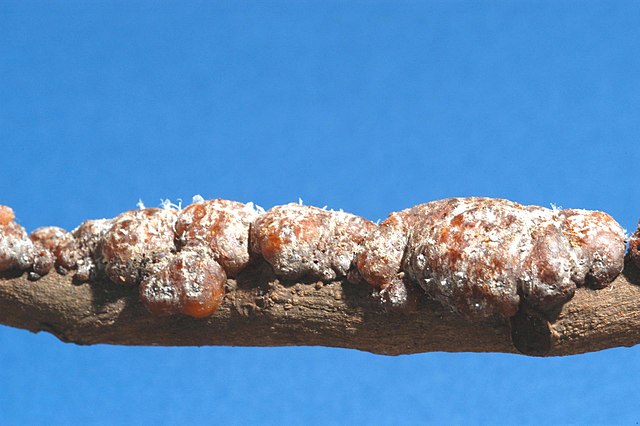
How does the female lac bug make plastic? They scrape bark from trees and mix it with a resin that they produce.
The female lac bug produces a resin, which is a plastic. Plastics are made when molecules connect together to make long chains of polymers. These are what give plastics their strength and durability. Resins start out as monomers, which is why they are a liquid. Then, depending on the type of resin, when they are exposed to heat, or another chemical, they undergo a process where the monomers become polymers and they set hard. They are useful because they can be molded into any shape and many of them are clear.
The resin from the female lac bug is called shellac. The word comes from French, but it came into French via Latin, Persian, Hindi, and Sanskrit. It is made up of “shell”, and “lac”. Shell is just a shell, but lac comes from Sanskrit and it was the name for the insect that we get shellac from. The insect was called lac because “lakh” means one hundred thousand in Sanskrit and it referred to how many of the bugs are on a tree because there can be over 150 in every square inch. The resin taken from the bugs became known as lac and that travelled via trade into French and then English. It is also the reason why lacquerware starts with “lac”.
There are several types of lac insects but the ones that are most commonly used for the resin are called Kerria lacca. They are very small. The largest adult females are only 1.9 mm long. They are parasites and when they infest a tree, there can be over a hundred thousand of them on the entire tree. If they are not controlled, lac bugs multiply like crazy and they can kill a tree very quickly. They do this by eating the nutrients that the tree needs and basically starving it to death.
When a lac bug reaches a tree, it borrows through the bark of the tree so it can get to the phloem. The phloem is the living part of the tree under the bark that transports all of the nutrients, water, and sugars around the tree. It is the part that maple syrup and rubber producers tap into. The bug borrows down to the phloem and starts to move along, eating as it goes. As they eat along, they produce their resin that is mixed with pieces of the tree’s bark and seal the cut they are making. The resin hardens, protecting the bug and keeping the tree alive for longer. One bug can be bad for a tree, but when you think that there are one hundred thousand or more of these bugs on a tree at any one time, you can see how quickly they can kill a tree.
This resin is very useful for us. To harvest it, the resin tunnels that the bugs make are scraped off and placed in a canvas bag. The bag is heated over a fire and the resin liquifies, seeping out of the bag. The pieces of bark and the bugs are left behind in the sac. The bugs themselves can then be used to make a dye, but often it is just the resin that people want. It can take up to 300,000 bugs to make 1 kg or shellac resin. The resin is then broken into pieces and powdered and sold. If it is liquid, it only has a one year shelf life, so it is kept in solid or powdered form before it is ready to be sold and then mixed with alcohol to liquify it. It takes hundreds of thousands of lac bugs to make enough shellac to sell. India produces over 20,000 tons of it a year, which is a staggering number of insects.
So, what do we use the resin from the lac bug for? Well, lacquer is a very common use, of course. It is also the main ingredient in French polish, which makes furniture look nice. It is used to polish string instruments and pianos. It is sometimes used as a paint primer because it can block stains and smells. It has many other uses, too. It is used in some fireworks. It is used in jewelry. It is used as a topcoat on nail polish. It is used to fasten the arrowheads to arrows. And, it has many uses in the food industry because shellac is edible. Jelly Belly jelly beans use it to get that shine. A lot of chocolate candies use shellac as the covering. It is used to protect citrus fruit and to make apples shiny. And this is what I learned today.
Image By Jeffrey W. Lotz – http://www.forestryimages.org/browse/detail.cfm?imgnum=5385241, CC BY 3.0, https://commons.wikimedia.org/w/index.php?curid=18477126
Sources
https://www.ncbi.nlm.nih.gov/pmc/articles/PMC9784800/
https://en.wikipedia.org/wiki/Shellac
https://en.wikipedia.org/wiki/Lac_(resin)
https://academic.oup.com/jinsectscience/article/11/1/106/2493290
https://www.woodworkingnetwork.com/archived/custom/shellac-and-female-lac-bug
https://europlas.com.vn/en-US/blog-1/what-is-plastic-resin-how-is-plastic-resin-made
https://www.etymonline.com/word/lacquer
https://www.etymonline.com/word/lac

